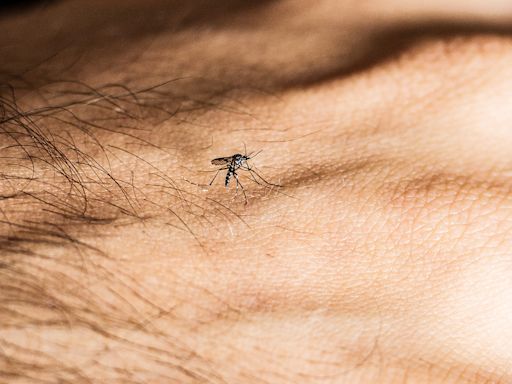Search results
May 14, 2024 · Key points. Dengue viruses are usually spread to people through the bites of infected Aedes species mosquitoes. A person infected with dengue during pregnancy can pass the virus to their fetus. Rarely, dengue can be spread through other routes. Through mosquito bites.
- Key Facts
- Overview
- Symptoms
- Diagnostics and Treatment
- Global Burden
- Transmission
- Risk Factors
- Prevention and Control
- Who Response
Dengue is a viral infection transmitted to humans through the bite of infected mosquitoes.About half of the world's population is now at risk of dengue with an estimated 100–400 million infections occurring each year.Dengue is found in tropical and sub-tropical climates worldwide, mostly in urban and semi-urban areas.While many dengue infections are asymptomatic or produce only mild illness, the virus can occasionally cause more severe cases, and even death.Dengue (break-bone fever) is a viral infection that spreads from mosquitoes to people. It is more common in tropical and subtropical climates. Most people who get dengue will not have symptoms. But for those who do, the most common symptoms are high fever, headache, body aches, nausea, and rash. Most will get better in 1–2 weeks. Some people develo...
Most people with dengue have mild or no symptoms and will get better in 1–2 weeks. Rarely, dengue can be severe and lead to death. If symptoms occur, they usually begin 4–10 days after infection and last for 2–7 days. Symptoms may include: 1. high fever (40°C/104°F) 2. severe headache 3. pain behind the eyes 4. muscle and joint pains 5. nausea 6. v...
There is no specific treatment for dengue. The focus is on treating pain symptoms. Most cases of dengue fever can be treated at home with pain medicine. Acetaminophen (paracetamol) is often used to control pain. Non-steroidal anti-inflammatory drugs like ibuprofen and aspirin are avoided as they can increase the risk of bleeding. For people with se...
The incidence of dengue has grown dramatically around the world in recent decades, with cases reported to WHO increasing from 505 430 cases in 2000 to 5.2 million in 2019. A vast majority of cases are asymptomatic or mild and self-managed, and hence the actual numbers of dengue cases are under-reported. Many cases are also misdiagnosed as other feb...
Transmission through the mosquito bite The dengue virus is transmitted to humans through the bites of infected female mosquitoes, primarily the Aedes aegypti mosquito. Other species within the Aedes genus can also act as vectors, but their contribution is normally secondary to Aedes aegypti. However, in 2023, a surge in local transmission of dengue...
Previous infection with DENV increases the risk of the individual developing severe dengue. Urbanization (especially unplanned), is associated with dengue transmission through multiple social and environmental factors: population density, human mobility, access to reliable water source, water storage practice etc. Community risks to dengue also dep...
The mosquitoes that spread dengue are active during the day. Lower the risk of getting dengue by protecting yourself from mosquito bites by using: 1. clothes that cover as much of your body as possible; 2. mosquito nets if sleeping during the day, ideally nets sprayed with insect repellent; 3. window screens; 4. mosquito repellents (containing DEET...
WHO responds to dengue in the following ways: 1. supports countries in the confirmation of outbreaks through its collaborating network of laboratories; 2. provides technical support and guidance to countries for the effective management of dengue outbreaks; 3. supports countries in improving their reporting systems and capture the true burden of th...
- Dengue viruses are spread to people through the bite of an infected Aedes species (Ae. aegypti or Ae. albopictus) mosquito. These mosquitoes also spread Zika, chikungunya, and other viruses.
- Dengue is common in more than 100 countries around the world.
- Forty percent of the world’s population, about 3 billion people, live in areas with a risk of dengue. Dengue is often a leading cause of illness in areas with risk.
- Each year, up to 400 million people get infected with dengue. Approximately 100 million people get sick from infection, and 22,000 die from severe dengue.
The dengue virus is transmitted to humans via the bite of an infected mosquito. Only a few mosquito species are vectors for the dengue virus. What is a vector? A vector is a vehicle...
Oct 5, 2022 · Headache. Muscle, bone or joint pain. Nausea. Vomiting. Pain behind the eyes. Swollen glands. Rash. Most people recover within a week or so. In some cases, symptoms worsen and can become life-threatening. This is called severe dengue, dengue hemorrhagic fever or dengue shock syndrome.
Oct 24, 2019 · Where does the disease occur? Dengue is mainly transmitted by a mosquito ( Aedes aegypti) and is distributed across all tropical countries. Ae. aegypti and other species such as Ae. albopictus are highly adaptive and their combined distribution can spread dengue higher up north across Europe or North America during summer.
A virus spread through mosquito bites. Aedes mosquitoes also spread chikungunya and Zika viruses. A risk to anyone traveling to a tropical or subtropical region of the world where dengue virus is found. Global risk. Each year, an estimated 390 million people are infected.

